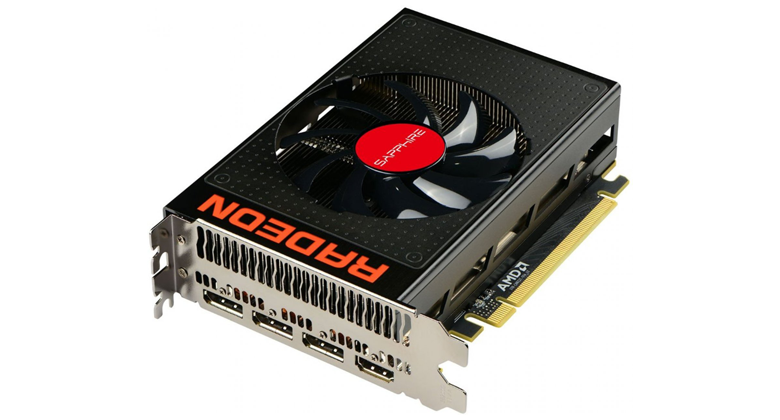I’m very fond of mini-ITX builds. There’s just a certain allure to having a beastly gaming rig occupying a mere one square foot of desk space. However, small form factor gaming graphics cards are few and far between, and most of the time, high-end cards arrive with big, bulky bodies that wreck your enclosure’s airflow, cable management, and thermals. Enter the AMD Radeon R9 Nano: a six-inch card that packs quite a wallop. We review Sapphire’s take on it below.
Specifications:
- Stream Processors: 4096
- Texture Units: 256
- Compute Units: 64
- ROPs: 64
- Core Speed: 1000 MHz
- VRAM: 4 GB HBM
- Memory Speed: 1000 MHz
- Memory Bus: 4096-bit
- Memory Bandwidth: 512 GB/s
- Power Requirement: 175 W; 8-pin PCIe power required
- Output: 3x DisplayPort, 1x HDMI
- Cooling: 90 mm single fan
- Others: CrossFire, PowerTune, ZeroCore Power, FreeSync, Eyefinity, HD3D, Liquid VR, Virtual Super Resolution, TrueAudio, Universal Video Decoder, and DirectX 12 ready
- Dimensions: Dual slot, 158 x 111 x 37 mm (L x W x D)
Design: 4/5
The Sapphire Radeon R9 Nano’s design is very vanilla. Don’t get me wrong; the card looks really good even though it doesn’t have the “wow” factor of its competitors. Its simple aesthetics is characterized by the matte black shroud with the red Radeon typeface—the same as the ones found on the R9 Fury and Fury X. Its front is also occupied by the 90 mm fan with the Sapphire marque in the center.
The shroud wraps around the card’s top and bottom edges, with diagonal cutouts to facilitate heat dispersion. The top also houses the redundant BIOS switch (does not affect performance), while the bottom is home to the gold PCIe fingers. Moving to the back, you’ll be greeted by the bare black PCB and the heat sink mounting bracket.
You’ll see the horizontal cooling fins that cover the card’s entire length on the right edge, along with the 8-pin power connector. Lastly, the left side features the exhaust grille and the display outputs.
Hardware: 4/5
At the Radeon R9 Nano’s heart is the Fiji GPU which, at the time of its unveiling, beat out the previous generation Hawaii architecture not only in raw power, but also in performance per watt. Featuring 4096 stream processors, 256 texture units, 64 compute units, and 64 ROPs, the card comes clocked at 1000 MHz and sips only 175 W from the wall. This Fiji-based card also struts 4 GB of High Bandwidth Memory with an effective speed of 1000 MHz. Data travels along a 4096-bit wide memory bus at a total rate of 512 GB/s.
Those specs are just shy of the liquid-cooled Fury X, with the X sporting a 50 MHz faster GPU speed, 0.41 TFLOPS faster performance, and 100 W more power consumption. This means that the R9 Nano won’t have the same performance headroom as the Fury X, though it is very powerful out of the box.
User Experience: 4.5/5
Nowadays, it’s rare to find a high-end card that disappoints and the Sapphire Radeon R9 Nano is no exception. Paired to my rig’s Intel Core i5-4460 and 8 GB of RAM, the R9 Nano easily managed its workload of Counter Strike: Global Offensive, Middle Earth: Shadow of Mordor, NBA 2K16, and Ashes of Singularity all at 1080p and maximum visual settings. Yes, it can also play Overwatch. With its horsepower, there’s no doubt in my mind that it can also handle the same titles at 4K, albeit not so much at 60+ fps, but definitely above 30 fps.
As for temperature, it hovered around 80° C throughout the tests, which isn’t bad considering my Fractal Design Define Nano S isn’t decked out with tons of aftermarket fans. The ambient temperature of my room is also on the warmer side so if the card’s cooling solution weren’t as good as it is, it could have easily reached searing 90° C temps.
Value: 3.5/5
Retailing for around PHP 33,000, the Sapphire Radeon R9 Nano performs slightly better than the Nvidia GTX 980 while being a bit more affordable and power efficient. However, this doesn’t mean that it’s the most cost-effective card in the market right now. Squeezing high-end technology into a card only half a ruler in length isn’t cheap by any means, but it’s nice to see AMD trying to push the envelope that is mini-ITX.
What’s Hot:
- Mini-ITX graphics card done right
- Decent temperature when under load
What’s Not:
- No LED lighting
- Price-to-performance ratio is steep
Bottomline:
- It’s the proverbial small package that good things come in.
Overall: 16/20

